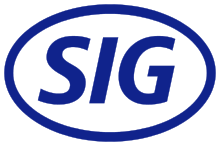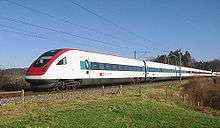SIG Combibloc Group
 | |
| Private | |
| Predecessor | SIG Holding AG |
| Founded | 1853 |
| Headquarters | Neuhausen am Rheinfall, Switzerland |
Key people | Rolf Stangl, CEO |
| Products | Liquid food and beverage packaging |
| Services | Aseptic cartons, filling equipment and service |
| Revenue | €1.721 million (2015) |
Number of employees | c. 5000 (2015) |
| Parent | ONEX Corporation |
| Divisions | SIG Combibloc |
| Website |
www |

Known by its initials, SIG, SIG Combibloc Group AG was previously known as SIG Holding AG,[1] and was originally founded as Schweizerische Industrie Gesellschaft (German for Swiss Industrial Company; in French, as Société Industrielle Suisse; and, in Italian, as Societa Industriale Svizzera). SIG Combibloc Group AG has been active in various businesses during its more than 170 years of operation. Since 2000, the company has undergone strategic refocus, selling the SIG Sauer branch to L & O Holdings, and focusing on its packaging operations, SIG Pack and SIG Beverages, then, solely, on its SIG Combibloc aseptic carton infrastructure and packaging division.[2]
In 2007, SIG Holding AG was acquired by Rank Group Limited, the private investment company of New Zealand businessman Graeme Hart, and operated under its subsidiary, Reynolds Group Holdings Ltd., which, in March 2015, announced completion of its sale of SIG to ONEX Corporation of Canada.[3]
History
The origins of the SIG-Sauer company is referenced in the company named, Schweizerische Waggon Fabrik, or, in English, Swiss Wagon Factory. The company was founded in 1853 by Friedrich Peyer im Hof, Heinrich Moser, and Johann Conrad Neher.[4][5] In 1860, a state-of-the-art rifle of their creation won a competition held by Switzerland's Federal Ministry of Defence, resulting in the award of a contract to produce 30,000 Prelaz-Burnand rifles. The Prélaz-Burnand 1859 was invented by gunsmith Jean-Louis Joseph Prélaz and forestry inspector Colonel Ėdouard Burnand (father of prolific Swiss painter Eugène Burnand[6]), and adapted as the M1863 rifle.
Firearms
Upon receiving the contract to produce rifles, the company name was changed to reflect its new emphasis on machined production, becoming Schweizerische Industrie Gesellschaft (SIG); in English, Swiss Industrial Company; and, in French, Société Industrielle Suisse.[4][7]
SIG produced other firearms and pioneered the first automatic rifle, the Mondragón Rifle, which was produced by SIG between 1908 and 1910.[8] The SIG P210 pistol was developed in 1937 based on the French Modèle 1935 pistol, and was adopted by the Swiss military in 1949 as the "Pistole 49". The single-action semi-automatic P210 brought SIG much acclaim, due to the precision manufacturing processes and resultant accuracy and reliability. The P210 frame design incorporates external rails that fit closely with the slide, thus eliminating play in the mechanism during firing. The P210 was noted for its extreme accuracy. The Petter-Browning patent was a refinement– and John Moses Browning's last design –of the Browning Hi-Power (P35).[9] In 1975, the Swiss military replaced the P210 with the P220, dubbed the "Pistole 75", and signalled the first product of a partnership between J.P. Sauer & Sohn. In a 1984 bidding contest to provide more than 300,000 sidearms to the US military, the SIG Sauer P226 was narrowly defeated by Beretta's 92FS which was awarded the contract for the M9 pistol. The SIG SG 510, or Sturmgewehr 57, battle rifle was produced by SIG from 1957 to 1983. Its appearance was vaguely similar to the German MG34 light machine-gun, due to its ventilated barrel jacket. It employed roller-delayed blowback, as used on the CETME/HK rifles.[10] The only general purpose machine gun produced by SIG was the SIG 710-3, which is based on the MG42.[11]
During the 1970s, SIG purchased both Hammerli[12][13] and J.P. Sauer and Sohn, resulting in the formation of SIG Sauer. Due to Swiss restrictions on the export of military weapons, SIG entered into a relationship with the German company J.P. Sauer & Sohn, in order to give SIG access to the global firearms market.
In January 1985, SIGARMS was established in Tyson's Corner, Virginia, where its handgun models P220 and P230 were imported into the USA from Sig Sauer in Germany. In 2007, SIGARMS changed its name to SIG Sauer. SIG Arms division was purchased in 2000 by L & O Holding,[14] and is now known as Swiss Arms.[15]
Railways
In the late 1970s, SIG was the designer and builder of Toronto's newest streetcar, the CLRV L1. Only the first six CLRV cars were made by SIG (out of an order for 10, as the rest were cancelled for cost-saving measures). The remaining 190 L2 vehicles, along with 52 articulated variants, were made by Thunder Bay, Ontario-based Urban Transportation Development Corporation (UTDC), now a subsidiary of Bombardier Transportation, which had, in late 1991, negotiated a $17 million subsidy from the Ontario government for the purchase.[16]
In the early 1980s, SIG was the designer and builder of the Utrecht sneltram trams. 27 were ordered and delivered in 1983 and are still running to date[17] (though scheduled for replacement during 2017 - 2018, and 2020).
The tilting system of the SBB RABDe 500 was developed by SIG. The railway branch of SIG was sold in 1995 to Fiat Ferroviaria.[18]
 SBB RABDe 500
SBB RABDe 500.jpg) SIG-built CLRV L1 4004 in Toronto
SIG-built CLRV L1 4004 in Toronto- ONR Northlander TEE train set
Packaging
The first packaging machines were produced in 1906 on behalf of the Lausanne-based company SAPAL (Société Anonyme des Plieuses Automatiques).
Most of SIG's earlier packaging equipment efforts were focused on small dry food items such as chocolates and candy. Following the 1982 FDA approval of hydrogen peroxide sterilization; on June 28, 1983, SIG acquired Doboy Packaging Machinery, Inc. of Wisconsin, growing its international presence. SIG COMBIBLOC INC. was then incorporated on September 1, 1983, in Columbus, Ohio, where production commenced in 1984. In 1989, through the acquisition of PKL in Linnich, Germany; SIG then entered the field of aseptic carton liquid packaging — this business grew significantly, and was later known as SIG Combibloc.[19][20]
In 2000, SIG concentrated solely on food and beverage packaging technology. Management directed revenues from the sales of SIG Sauer and Rocktools to acquire global businesses, including Krupp Kunstofftechnik (Corpoplast/Blowtec/Kautex brands) and HAMBA in Germany; Ryka Blow Molds in Canada; and a substantial portion of the Italian conglomerate SASIB. The food-related (dry) businesses were organized under the SIG Pack division, while the beverage-related (wet) businesses formed SIG Beverages. Aseptic liquid packaging remained separate under SIG Combibloc.[21]
This strategy, while intended to provide common customer bases with turnkey solutions for entire bottling or packaging lines, never gained enough momentum to be of any durable competitive advantage. Difficulties integrating vastly different businesses and employee cultures resulted in operational execution issues. In particular, high-profile commissioning and installation failures at SIG Beverages in 2003 and 2004 ultimately resulted in erosion of goodwill serious enough to be recorded on financial statements. A refocusing towards primarily aseptics and PET blow-molding resulted in a high number of divestitures and plant closures. The former SASIB wet businesses Simonazzi, Alfa and Meyer/Mojonnier were sold to Tetra Laval in 2005, while HAMBA and Kautex and Blowtec were sold separately to private investor groups. The food packaging businesses were sold to Robert Bosch Verpackungstechnik in 2004. The former SASIB dry unit Stewart Systems (bakery products) was sold to UCA Group in 2004, then merged with AMF Bakery Systems in 2008. Laser-guided vehicle manufacturer Elettric 80, part of the 1999 SASIB acquisition, was sold back to its original Italian owners in 2004.[22] The considerably slimmed-down SIG Beverages unit, manufacturer of PET bottle blow-molding machinery, was sold off to the German concern Salzgitter in March 2008. This sale encompassed the subsidiaries Corpoplast, Asbofill, Plasmax and Moldtec.
SIG Combibloc
SIG Combibloc focuses on aseptic packaging and remains an innovator in the liquid food and beverage packaging industry, providing full-scale systems and manufacturing supplies for companies in over 65 countries. In 2016, the company introduced Combibloc RS Composite, a composite structural inner layer which increases system stability and reduces the carbon footprint of carton packs.[23] In 2017, SIG introduced the first individual QR codes with digital sourcing transparency, tailored for dairy product consumers.[24]
See also
References
- ↑ Bloomberg "Company Overview of SIG Combibloc Group AG", Bloomberg Snapshots. Retrieved July 29, 2018.
- ↑ http://listofcompanies.co.in/2012/03/11/sig-holding-ag/
- ↑ Businesswire "Reynolds Group Holdings Limited Announced Closing of Sale of SIG Combibloc Business", March 13, 2015. Retrieved August 22, 2018.
- 1 2 "History - Sig Sauer". SigSauer.com. Retrieved 29 April 2017.
- ↑ http://www.guns-review.com/innovaeditor/assets/SigSauerMCX_516/founders_5.jpg%7CPhoto%5Bpermanent+dead+link%5D of Founder
- ↑ "Eugène Burnand Biographic Information", "Eugène Burnand, the man, the artist and his work, by René Burnand, MD Berger-Levrault, Paris, 1926 via eugene-burnand.com Retrieved August 30, 2018.
- ↑ Sig-Sauer Law Enforcement Archived 2012-03-11 at the Wayback Machine.
- ↑ Firestone, Adam C. "Historic Firearm of the Month, February 2001". Cruffler.com. Retrieved 29 April 2017.
- ↑ "Sig P210". ForgottenWeapons.com. 2 December 2011. Retrieved 29 April 2017.
- ↑ "SIG Stgw 57". ForgottenWeapons.com. 23 September 2011. Retrieved 29 April 2017.
- ↑ "Modern Firearms - SIG MG 710". Guns.ru. Retrieved 29 April 2017.
- ↑ GmbH, CARL WALTHER. "Home - Hämmerli Website". Haemmerli.info. Retrieved 29 April 2017.
- ↑ "SIG-Hammerli Trailside/X-Esse". TonyBrong.Blogspot.com. Retrieved 29 April 2017.
- ↑ Samsel, Aaron (31 May 2013). "SIG SAUER Parent Company Buys GSG, supplier of SIG 1911-22 Handguns". Guns.com. Retrieved 29 April 2017.
- ↑ Kapella, Jürgen. "Swiss Arms: Startseite". SwissArms.ch. Retrieved 29 April 2017.
- ↑ Farnsworth, Clyde H. "Bombardier Returns to Earth", The New York Times, December 28, 1991. Retrieved August 31, 2018.
- ↑ "Zwitserse trams in Utrecht". 29 October 2016. Retrieved 29 April 2017 – via Wikipedia.
- ↑ "The Northlander". UWyo.edu. Retrieved 29 April 2017.
- ↑ Shurtleff, W., et al History of Soybeans and Soyfoods in Austria and Switzerland (1781-2015), by William Shurtleff and Akiko Aoyagi, Soyinfo Center, 2015, page 564. Retrieved August 22, 2018.
- ↑ Ohio-Register "SIG COMBIBLOC INC.", ohio-register.com. Retrieved August 22, 2018.
- ↑ http://www.sig.biz/sig-global/en/sig-global/
- ↑ Pontecorvo,Laura "Elettric 80: the Eagle is back! — Elettric 80, which has become 100% Italian again after a few years spent in the Swiss group SIG, confirms its character as innovative company in the field of integrated logistics systems", Perini Journal (PJL-23), 2004. Retrieved August 31, 2018.
- ↑ RISI "Germany's SIG Combibloc develops new combibloc RS composite structure for carton packs", RISI Technology Channels, December 15, 2016. Retrieved August 22, 2018.
- ↑ Brand Packaging, Brand Packaging Magazine, May 31, 2017. Retrieved August 22, 2018.
External links
| Wikimedia Commons has media related to SIG Combibloc Group. |